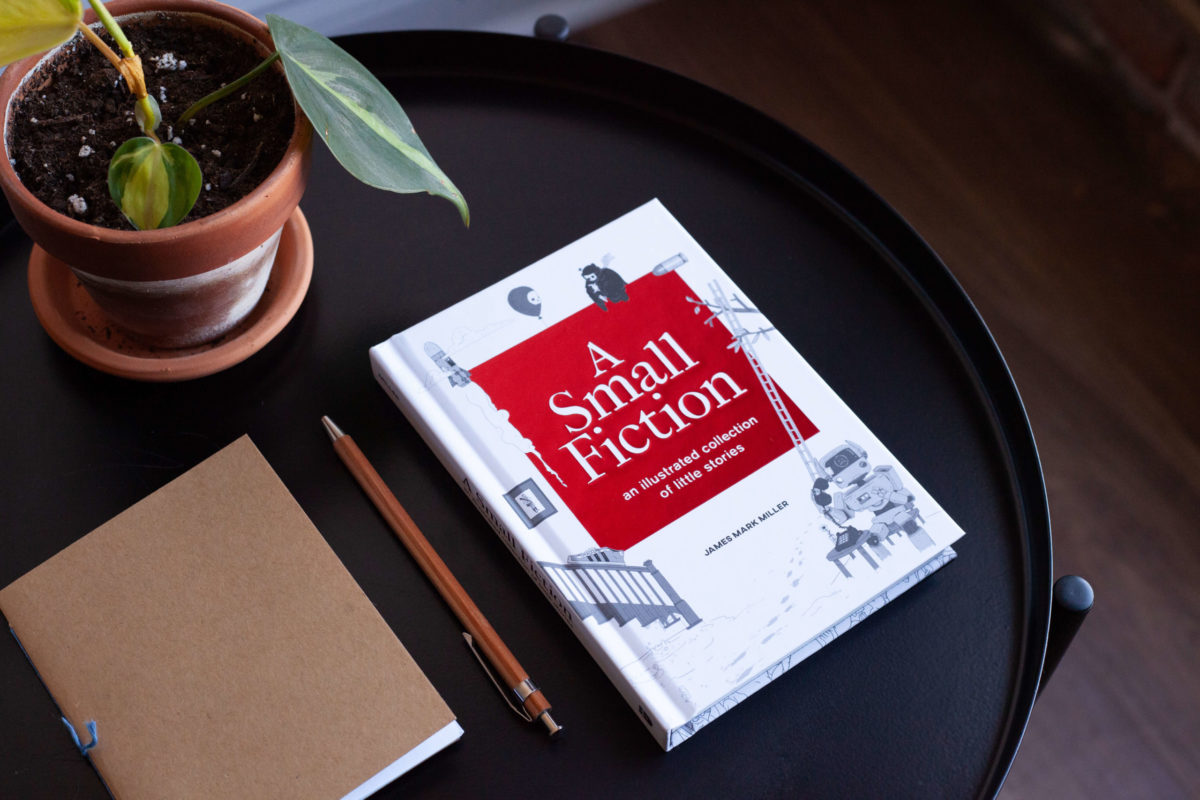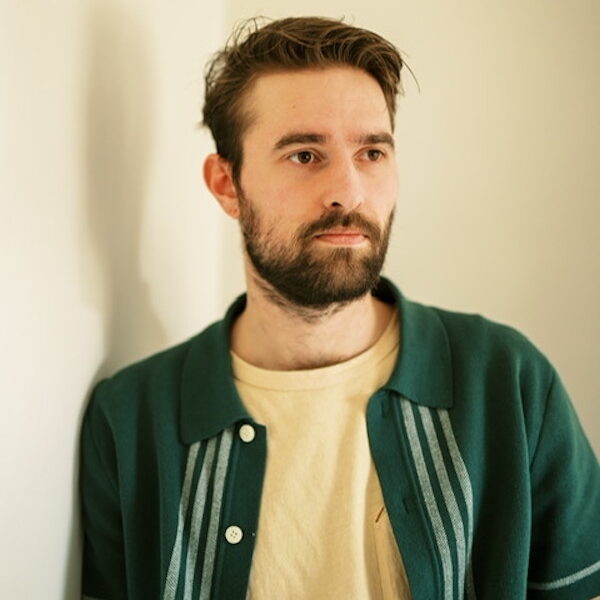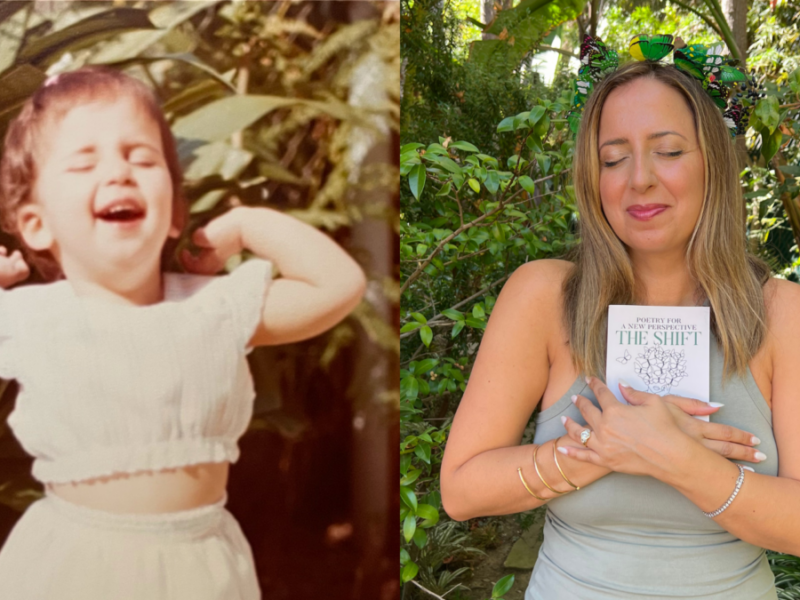Behind A Little Book with Big Ideas: Meet the Creators of A Small Fiction
Brothers James and Jefferson Miller have a tried-and-true history of working together. James, a writer, and Jefferson (Jeff), an illustrator, have combined their storytelling skills on a number of projects, including the webcomic Dear Toadington and the forthcoming short story collection A Small Fiction (October 6, 2020). Although the book started as James’s personal pact to write a new story each day for a year, it quickly blossomed into a twitter account (@ASmallFiction) with over 131 thousand followers. A Small Fiction shares bite-sized stories that take on themes of the paranormal, science fiction and AI, childhood nostalgia, and existential dread—but not without a sense of humor. For a peek behind this little book with big ideas, we sat down for a Q&A with creators James and Jeff.
Thea Voutiritsas (TV): Can you tell us the origin story of Embros Creative? As brothers, have you always liked working together?
James and Jeff: The first answer sort of comes out of the second answer. We really have always enjoyed working together. We made short films and skits and whole imaginary worlds when we were little kids, and as we got older that never stopped. Comics, brands, games, films, scripts, books, you name it. We were born creative collaborators. At some point, we realized that to do all these very different things it would be helpful to have a brand that could encompass them all and tie all these disparate things together.
TV: What are some of the rewards and challenges of working with a close friend/family member—or in this case—a brother?
James: Assuming that it’s someone you get along with, it can be a lot easier. You have an established communication style, you know how to give each other feedback. Most importantly, with work that you put so much of yourself into, working with a sibling means working with someone that matters to you more than the project does, so it helps keep perspective. If a creative project doesn’t succeed, it doesn’t matter as much when you’re just happy because you have fun sharing that process. We haven’t really run into any challenges.
Jeff: Working with someone you’re so close with makes any reward that much better. Waking up to exciting news is way more fun when you can call someone who will be just as excited as you are and be like, “Yoooo, dude! Did you see the email we just got?” Every project is another opportunity to hang out with your best friend. There isn’t a lot of butting heads or the things you might expect from brothers working in such a close capacity. If we do run into anything “challenging,” it might just be that we think the same things are funny, so I’m not as reliable of a soundboard as, say, someone with a different sense of humor. I like everything he writes.
TV: Do you have a favorite poem or poet? And how might their work have influenced yours?
James: This is a difficult question for me. I’m not very good with favorites. I collect poems in a very crow-and-bottle-cap way; my favorites are a hodge-podge collection of loved and important acquisitions that don’t often resemble each other very much.
In that, maybe I’ve been most influenced by the variety of voices and ideas that I’ve loved at one time or another. Dickenson’s novel cadences and punctuation, Shel Silverstein’s humor on a stark white space, William Carlos Williams with his vivid brevity, a sign in my grandpa’s workshop with a short verse about bees and birth control that I’ve never been able to source—it’s all in there. We’re all a little bit the sum of what we gather into ourselves.
TV: The book began with a goal to write one new micro-fiction story each day. James, how did that year of writing go? What were some of the ups and downs of writing something new each day?
James: It was a challenge, but the first year of updating daily was one of the easiest. I wasn’t intending to write for an audience, and the whole thing was a steam valve. I challenged myself to write some new thing for myself every day because I was writing for a living and finding that I was using all of my creative energy for someone else, so I needed to balance that.
It was fun to sit down with no idea what I would write about and not have any direction on what I was writing, and I found that I got a lot of satisfaction from a project that let me write things and let go of them and move on to the next, instead of working and reworking and revisiting. If I wrote something I wasn’t particularly thrilled with, the next day was a clean slate.
Writing something new every day is something that weighs heavier over time, of course. The fourth year was certainly not as breezy as the first; finding fresh ideas and not comparing them to the hundreds that came before them gets more difficult.
TV: A Small Fiction offers readers an array of rich emotions. One story might ask us to confront existential questions, and the next could make us laugh out loud. How did you go about organizing the short stories for the book?
James: I’m really glad you asked this; it’s something that I thought about a lot. At first, I wanted the order to be completely random—there’s no order to the way they were written, why should there be any to the way that they’re organized?
As we progressed with the book, however, I found myself wanting them to follow a flow or thread. Instead of being chaotic, I wanted them to have a kind of internal logic, like a dream or a stream of consciousness.
So I spent a month or so moving them around until I felt happy with the way that thread connected each to the one before and after through a word or tone or atmosphere.
I wasn’t sure it would matter to anyone but me, but I was pleased with it.
TV: With 131.3K twitter followers, A Small Fiction is far from small. When did you first notice the project gaining traction in the public eye? Did that influence your work going forward?
James: I’d say I noticed in a series of steps. That sense of traction came whenever there was a surge that changed the equilibrium, but then that would become the new normal. That’s still the case. It was just as exciting to get the first comment from a stranger as it was to get the first comment from a public figure. Ten thousand was as exciting as a hundred thousand. Every milestone feels like the big one, but then you’re waiting for the next one.
The very first time was when a story about a “compliment duel” took off. That was the one where I had to turn off notifications on my phone. It popped up all over the place, and people in my life started telling me they’d seen it somewhere they hadn’t expected it.
I’d like to say that I haven’t let the size of the audience influence the writing too much. No matter how many people are reading each one, or how they react to it, I still write them the same way and with the same mindset as I did in the beginning. When I write one I like, I’m happy. When I write one I don’t like so much, I’m satisfied that I wrote something at all. Either way, the next day is a blank slate.
TV: How did you decide which stories to illustrate?
Jeff: It was a combination of things. With some stories, we saw an opportunity to add a fun detail or expand on the idea behind the story, but with others, it was just an image that kept coming back to us that would crack us up, like the little, tiny grave in the story about the tortoise and the hare. What it came down to was James and I reading through the stories together, and any story that we had an immediate image in mind for, we would add to a list, and then we chose our favorites to include in the book. I knew from the jump that I needed to do an illustration for the “Mankind always yearned for the stars” story.
TV: What is one thing you would want readers to know about the book?
James: It has a lot of personal value and history. It isn’t just a collection of stories; it’s a lot of little slivers of my life and it means quite a bit to me. One of the stories in this book is the one that I wrote to propose to my wife. Another one is about aliens meeting my mom.
TV: What do you see for the future of A Small Fiction?
James and Jeff: More illustrated collections, we hope. There are almost two thousand A Small Fiction stories written. It would be nice for more of them to have a page to live on.
If you want to check out A Small Fiction (Oct. 6, 2020, Andrews McMeel Publishing), you can order the book here.




